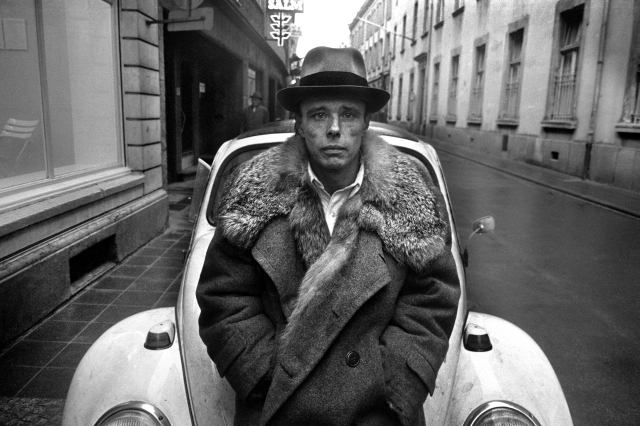 Joseph Beuys
Joseph Beuys
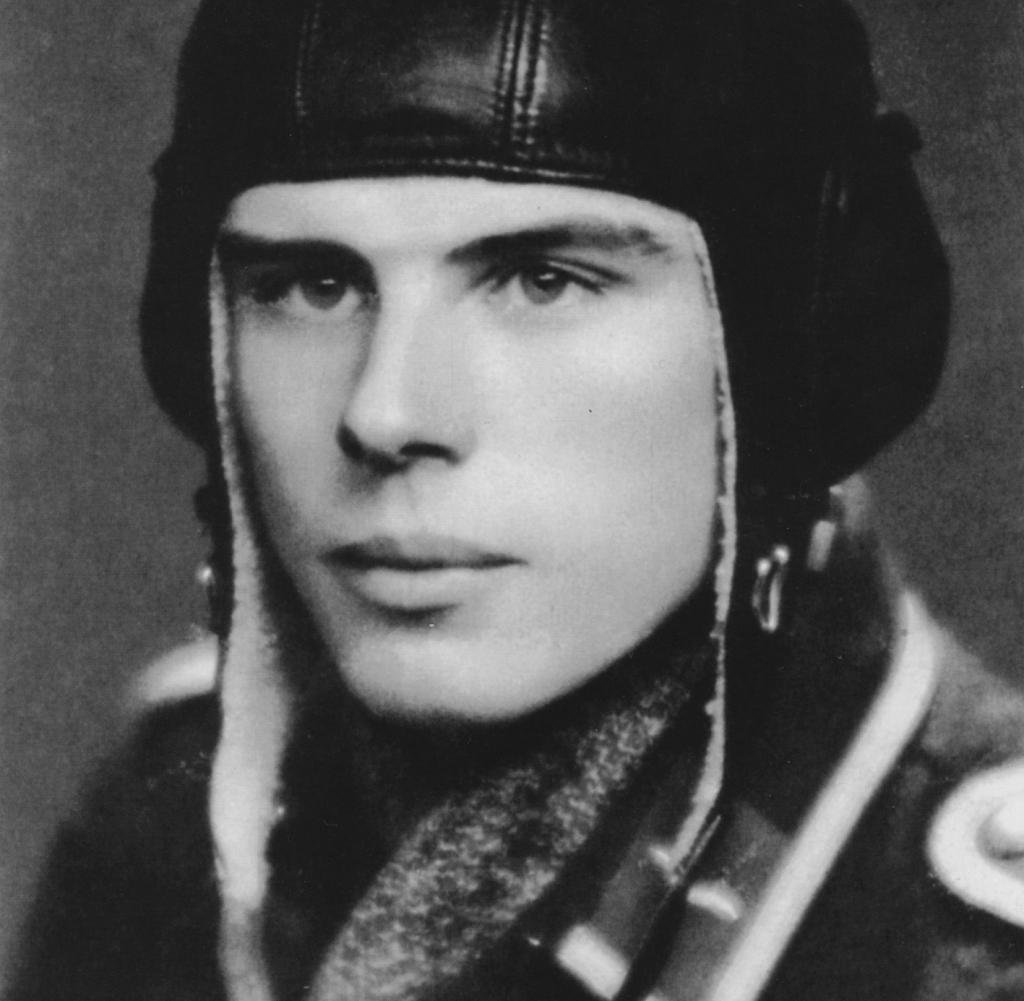 J. Beuys 1943, en la Segunda Guerra Mundial.
J. Beuys 1943, en la Segunda Guerra Mundial.
Biography
Sculptor, draftsman, performer, teacher and political activist, Joseph Beuys is born in 1921 in Krefeld, Germany.
He spends most of his childhood in Kleve and Rindern, where in 1930 his father opened a business of flour and fodder. There, Beuys begins collecting all kinds of plants, insects and animals that he and his friends show in public in small "exhibitions". He builds his first makeshift laboratory in his home to make experiments. A practice maintained throughout his life. Besides his amateur forays into the realm of the natural sciences, he continues to develop his artistic inclinations and his talent for drawing and music that are enhanced by cello and piano classes.
In his youth, he meets the sculptor Achilles Moortgat (1881-1957), artist from Kleve whose work is linked to the tradition of the Academy of Brussels, through him he discovers the work of artists Constantin Meunier and Georges Minne.
During World War II, he enlists in the Air Force (Luftwaffe) as pilot of a fighter bomber. In 1943, flying the Crimea during a snowstorm, he is shot down and badly wounded. Beuys is rescued by Tartars, who heal him, feed him with honey, treat his body with herbs and coated him with fat and felt to recover the heat and vitality. This fact ??between real and mythical defines Beuys 's artistic production throughout his life.
After the war in 1945, Beuys decides to devote himself to artistic practice and begin to draw and paint water colors. In 1946 he meets Hans and Josef Van der Grinten, who become the first major collectors of his work as well as the founders of Joseph Beuys Archivan Nordrhein -Westfalen (Joseph Beuys Archive of North Rhine - Westphalia).
From 1947 until 1951, he studies sculpture at the Düsseldorf Academy, an institution that ten years later assigns him as teacher in the matter. His interest in Rudolf Steiner and anthroposophy, Christianity, mythology and shamanism, botany and zoology led him to develop a rich and complex symbolism, incorporating archetypal images of animals such as rabbits, sheep, swans, bees, etc. In 1953 he exhibits individually at the home of the brothers Van der Grinten in Kranenebourg, exposing a selection of sculptures, woodcuts and drawings, later known as series the " Barn Spectacle".
Beuys goes through a serious depression in 1955 caused by doubts about his work as an artist, money problems and experiences of the Second World War. The following year, Beuys lives and works in the Van der Grinten family farm in Kranenburg, where he recovers, starts drawing again and renews his interest in scientific, artistic, and philosophical issues.
In 1959 he marries Eva Wurmbach, an art teacher he meets during a party at the Düsseldorf Academy. In 1960, he offers his first major solo show, accompanied by a catalogue, at the Museum Koekkoek in Kleve.
In 1961 he moves to Düsseldorf to work as a professor of sculpture. There he meets and starts a friendship with Nam June Paik and connects with the Fluxus group, who´s multidisciplinary and performative works generate a new direction in his production. He takes part of Fluxus between 1962 and 1964, a period which begins performances - actions using items such as dead hares, fat and felt. In 1963 performs "Symphony Siberian " first of many performances that Beuys undertaken under the name of Aktion (action), introducing sculptural objects, animals, stories, etc. In 1964 his participation in Documenta III in Kassel, where he presents drawings and sculptures from the period 1951 to 1959, marks the first exhibition to a wider audience.
Since then, his interest as an artist focuses on the organization of conferences and political actions. In 1967 he founds the Deutschen als Studentenpartei Metapartei (Student Party as Metaparty) and later, in 1971, creates the Organization für Demokratie direkte durch Volksabstimmung (Organization for Direct Democracy through Referendum) where he outlines his principles through performative lectures. In 1972, his expulsion from the Academy of Düsseldorf, caused by conflicts with authority about his ideas and teaching methods, generates a student strike and widespread protests. Years later, Beuys gets back his study at the Academy, but rejects his position as a teacher.
In 1974 he travels to the United States for the first time where he conducts his famous and longest action: “I like America and America likes me”, where Beuys cohabits with a coyote for three days, in the René Block art gallery of Manhattan, divided from the public only by a fence. That same year, his first exhibition in France, in the Bema art gallery of Paris. In 1978, Beuys is appointed member of the Academy of Fine Arts in Berlin. The 18th May 1979, he meets with Andy Warhol at Hans Mayer 's gallery in Düsseldorf . After this meeting, Beuys creates the multiple “Das Warhol-Beuys Ereignis” (The Happening Warhol-Beuys), and Warhol begins a series of portraits of Beuys. Months later he takes part, as the sole representative of West Germany, at the International São Paulo Biennial.
In November 1979, he presented his first retrospective exhibition at the Guggenheim Museum in New York, its set up and assembly are done by the artist in collaboration with Caroline Tisdall. This exhibition is the first presentation of the work of Beuys and his ideas to the public of North America, who only had the opportunity to see his work during readings and his action in the René Block Gallery in 1974.
In early 1980, Beuys donates eight hundred works on paper to Sztuki Museum of Lodz in Poland. He sees this action as a gesture of reconciliation against the division of Europe into Eastern and Western blocs. In 1982, participates in the Kassel Documenta VII with “7,000 oaks” action performed in conjunction with the argentine artist Nicolas Garcia Uriburu, in which he intends to plant 7000 trees with basalt blocks in front of the museum Fridericianum of Kassel; such action is completed in 5 years.
In full activity and development of conceptual work that ranks him among the most inspiring artists of the second half of the twentieth century, Joseph Beuys dies in 1986 at his studio in Düsseldorf , at 65 years of age.
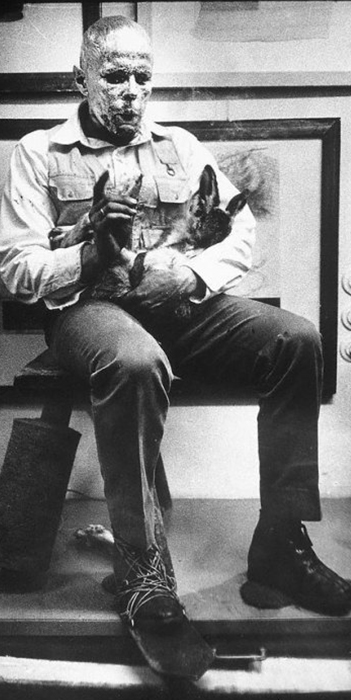 Wie man dem totem Hasen die Bildererklart, 1965
Wie man dem totem Hasen die Bildererklart, 1965
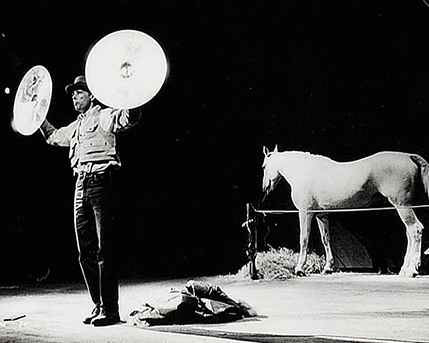 Ephigenie, 1973
Ephigenie, 1973
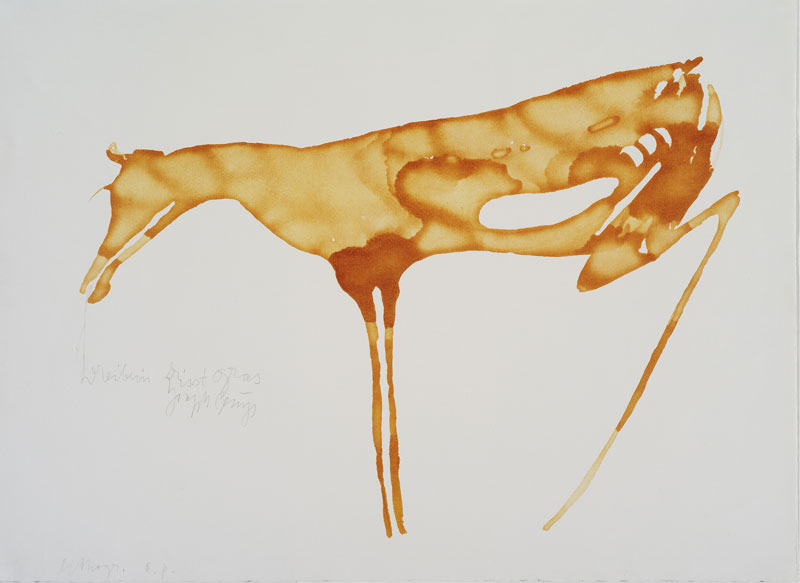 Hirschkuh, 1979
Hirschkuh, 1979
Chronology
1921: Joseph Beuys was born on May 12 in Krefeld, being the only child of the couple.
1930: With his friends, he sets up small "exhibitions" with all sorts of plants and animals gathered from his environment, and he builds his first domestic laboratory.
1937: During his youth, he discovers the work of artists from his region, and seriously considers initiating an artistic career.
1943: During the Second World War, after pilot's training, he is listed in the Air Force. On Crimea's front, his plane is blown down and the German army rescues him. Later, Beuys will refer to this episode with a mythical story in which he's rescued by a Tartar tribe, who cures treat him. They treat his body with herbs and fat and cover it with felt to make him recover heat and vitality.
1946: He meets the brothers Van der Grinten, the first collectors of his work, who will later turn into intimate friends of his and will create Joseph Beuys Nordrhein-Westfalen's Archive, still active nowadays (http://www.moyland.de).
1947: During four years, he studies sculpture in the National Art Academy of Düsseldorf, institution that ten years later will designate him as a professor in this discipline. This is a period of intense creative and intellectual exchange, during which he develops his interest for Rudolf Steiner and the anthroposophy, Christianity, mythology, shamanism, botany and zoology.
1949: He generates his own sculptural language, in which the stylized formalism of Düsseldorf's Academy makes way to a personal symbolism, incorporating archetypal images of animals like hares, sheeps, deer, swans and bees.
1951: He finished his training in the National Art Academy as a pupil of Ewald Mataré (1887-1965). The brothers Van der Grinten buy him the two first artworks of his extended collection.
1953: He sets up his first individual exhibition in the house of the brothers Van der Grinten, known as the "Spectacle of the Barn", where he exhibits 85 works, among them sculptures, engravings on wood and drawings.
1956: He goes through a period of crisis. After looking for help in psychiatric clinics of the region, he recovers on the following year in company of the brothers Van der Grinten.
1958: He begins the cycle of Ulises's drawings, which he entitles " 4 Books of the Project Western Man ", that will be completed in 1965.
The German gallery owner Alfred Schmela (1918-1980) introduces him to Yves Klein, among other artists, and invites him to realize an exhibition in his gallery. It will finally happen in 1965.
During the spring, he meets the Art professor Eva Wurmbach, daughter of a well-known animal scientist, whom he will marry in 1959.
His father, Josef Jakob Beuys, dies.
1960: Beuys and his wife, Eve, move to Düsseldorf, and his house and studio will remain in this city for 25 years.
1961: At the age of forty, he access to the public scene. The exhibition "Joseph Beuys" is organized in the Koekkoek Museum of Kleve; it’s the first show of the artist accompanied by a catalogue. The exhibition gathers up drawings, watercolours, oils and sculptures from the Van der Grinten collection.
He is nominated as teacher of Monumental Sculpture in Düsseldorf's Academy.
Birth of his first son, Boien Wenzel Beuys.
1962: A great friendship with Nam June Paik begins and links Beuys with the group Fluxus, whose multidisciplinary and performing artworks encourage a new development in his production. He takes part of the group’s activities between 1962 and 1964.
1963: He realizes the "Siberian Symphony", first of many performances that he undertakes under the name Aktion (Action), introducing objects, animals, stories, and materials like fat and felt. In this case, he uses a blackboard like a sculptural object, which forms part of his Actions and art installations a long time before his conferences and political actions in the seventies.
1964: His participation in the Documenta III of Kassel, with works of the period 1951 - 1959, marks the first exhibition of the artist for a more numerous public.
He stops any participation to the Fluxus group, because of philosophical and aesthetic differences. His performances are considered too personal, expressive and symbolic.
He realizes the Action The Silence of Marcel Duchamp is overrated in a television studio of Düsseldorf, and the show is broadcasted live.
Birth of his daughter, Jessyka Beuys.
1965: In the Alfred Schmela gallery, he presents his legendary Action How to Explain Pictures to a Dead Hare. Schmela records the work that is realized inside closed doors and then the video is projected.
1966: At the same time, he goes on producing artworks in felt.
1967: His artistic interest focuses in the organization of conferences and political actions. As spokesperson of the student movement, he founds the Deutschen Studentenpartei als Metapartei.
1968: Beuys participates in the Documenta IV of Kassel with artworks of the period 1952 - 1968 from the Stroher collection.
1971: He creates the Bureau for Direct Democracy through Referendum (Organization für direkte Demokratie durch Volksabstimmung), and expounds his principles, like ideas of fraternity, liberty and equality taken from the French Revolution, by means of conversations and performances. He initiates some projects for the Free International University for Creativity, and tries to integrate artistic and sociological studies.
1972: After the manifestation of the 1 º of May, he sweeps Karl Marx Square of Berlin, gathers up the garbage in bags of the " Organization of Not Voters in favour of the Free Referendum " and exhibits it in the René Block gallery. The action is entitled "Sweep" (Ausfeaen).
During Documenta V, he produces the action “Beuys Boxes for Direct Democracy” for the closing time of the one hundred days for Direct Democracy, which consists in boxing one of the exhibition organiser on the day 101. After three rounds, the referee proclaims him winner “For Direct Democracy by direct knocks”.
Beuys is expelled from Düsseldorf's Academy because of conflicts with authorities concerning his ideas and methods of education, which generates a students' strike and widespread protests. Years later, Beuys recovers his studio in the Academy, but refuses to start again as professor.
1973: He creates the Free International University for Creativity and Interdisciplinary Research – FIU, as a space for researches, work and communication.
1974: For the first time, Beuys travels to USA, where he produces his lengthiest action, “I like America and America likes me”, in which he lives together with a coyote in a gallery. He’s only separated from the audience by a wire fence.
His mother, Johanna Beuys, dies.
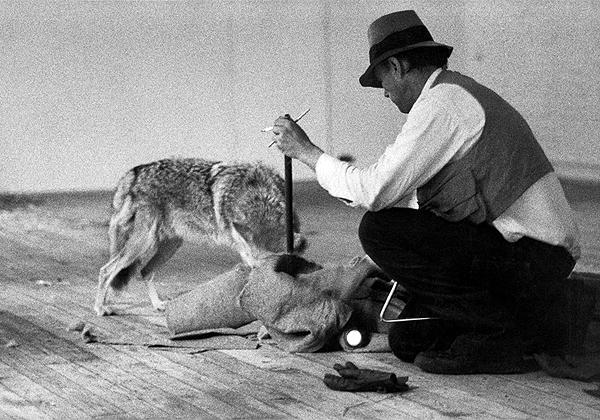
"Me gusta Estados Unidos y a Estados Unidos le gusto yo",1974. (Imagen fija de video)
1977: During Documenta VI, Beuys opens an Information Office of the 100 days of the Free International University for Creativity and Interdisciplinary Research (100 Tage Freien lnternationalen Hochschule für Kreativität und lnterdisziplinäre Forschung).
1979: Beuys, founder member of the Green party in Germany, is chosen as candidate in the legislative elections for the European parliament and designs the electoral poster. The Green party earns 3.2 % of the votes on June 10, and isn’t represented anymore in the Parliament.
First encounter between Joseph Beuys and Andy Warhol in Düsseldorf. After this meeting, Beuys creates the multiple Das Warhol-Beuys Ereignis (The Warhol-Beuys Happening), and Warhol begins creating a series of portraits of Beuys.
He works on the organization and montage of the exhibition "Joseph Beuys", the first and only great retrospective at the Museum Guggenheim of New York during his life, organized in collaboration with Caroline Tisdall.
1981: Colouring of the Rhine together with Nicolás García Uriburu in the aim of drawing attention on its pollution.
1982: He’s a part of Documenta VII with 7000 Oaks (7000 Eichen), action in which he offers to plant 7000 trees, each one put next to a basalt block, everywhere in Kassel. The basalt blocks are piled up in front of the Fridericianum Museum, with the idea of a reduction of the pile each time a tree is planted.
He protests against military dictatorship in Turkey during an official visit of the american president Ronald Reagan. He performs the song Sonne statt Reagan,with the band BAP in front of 30 000 people. He takes advantage of the phonetics of the german word “rain”. “Regen”, to criticize Reagan.
1984: As a part of his project “Difesa Della Natura”, he begins planting 400 trees and bushes in the area of Bolognago, under the auspices of the Baron Giuseppe Durini. A part of this action is shown in the Lucrezia de Domizi gallery.
1986: In full activity and development of his conceptual work, which positions him among the most inspiring artists of the second half of the 20th century, Joseph Beuys dies in 1986 in his study of Düsseldorf, at the age of 65.